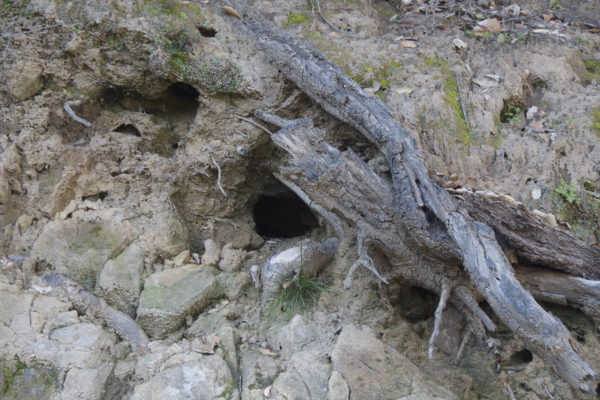 I often hike the trails below Mt. Diablo and am not a stranger to seeing snakes on the path, and have been told that in stretches of certain trails, rattlesnakes peer out from under the rocks. But on a recent hike, I was startled to actually make eye contact with a rattler! It was hiding in the hole underneath this gnarled tree trunk.
I often hike the trails below Mt. Diablo and am not a stranger to seeing snakes on the path, and have been told that in stretches of certain trails, rattlesnakes peer out from under the rocks. But on a recent hike, I was startled to actually make eye contact with a rattler! It was hiding in the hole underneath this gnarled tree trunk.
While snakes themselves have a rich symbolic history, today I want to talk more about the scary underground place it comes from.
I was reminded of a story I read to my daughters when they were young. The fable inspired lots of discussion in our home, and I believe it was formative for them.
The story was originally told to Rumi, the 13th-century Persian poet.
A caravan of men and camels crossed a desert and reached a place where they expected to find water. Instead they found only a hole going deep into the earth. They lowered bucket after bucket into the hole, but the rope each time came back empty—no bucket and no water. They then began to lower men into the hole but the men, too, disappeared from the end of the rope. Finally a wise man among the party volunteered to go down into the hole in search of water.
When the wise man reached the bottom of the hole, he found himself face to face with a horrible monster. The wise man thought to himself, “I can’t hope to escape from this place, but I can at least remain aware of everything I am experiencing.”
The monster said to him, “I will let you go only if you answer my question.”
The wise man replied, “Ask your question.”The monster said, “Where is the best place to be?”
The wise man thought to himself, “I don’t want to hurt his feelings. If I name some beautiful city, he may think I’m disparaging his hometown. Or maybe his hole is the place he thinks is best.”
So he said to the monster, “The best place to be is wherever you feel at home—even if it’s a hole in the ground.”
The monster said, “You are so wise that I will not only let you go, but I will also free the foolish men who came down before you. And I will release the water in this well.”
Wisdom and Choice
What made the wise man wise? He had a choice. He could go down into the darkness or not. He chose to descend into the hole even though it was doubtful that he would come back up again. He also chose to remain aware. He said, “I can at least remain aware of everything I am experiencing.” He showed kindness and compassion, without an agenda to beat the monster at his riddle. Through awareness and courtesy, he sets free his companions and releases the water.
Healing Comes from Confronting our Difficult, Dark Sides
Symbolically, this story illustrates a path to healing. In psychotherapy, we are often confronted with feelings that come from deep in the unconscious. By taking the difficult route into the darker places within, we can come back with deeper self-knowledge. When people begin individual therapy, they are often hesitant to look at the dark, secret places they keep tucked away. Psychotherapy is an opportunity to dig deeper and to face the darkness within, to remain aware and open to experience in the search for insight.
When we start down the path of self-understanding, we must choose to look at the discarded parts of ourselves. In this process, we can free ourselves from the things that hold us back from being truly alive. No one is without stain—without what seems like a monster inside. It is by entering the darkness that we can release the water, the substance of life, thereby slaking our thirst for wholeness.
- Psychotherapy in the Virtual Space: How teletherapy has changed the way we give and get care - April 26, 2021
- (home video area – couples counseling) - November 23, 2011
- (home video area – mindfulness) - November 23, 2011


Leave a Reply